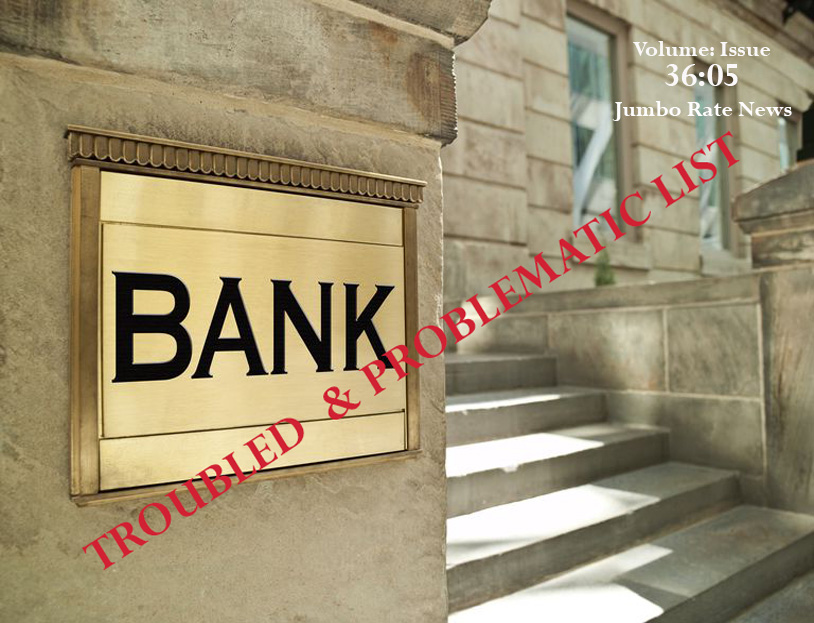Even though there are fewer banks rated 2-Star or below than there have been since 2007, there are still too many (83 to be exact) to list on page 7. Instead we listed all banks rated 1-Star or Zero-Stars OR rated 2-Stars but also having a regulatory classification of anything less than “Well-Capitalized”.
All but five of the selected banks are operating under some kind of supervisory enforcement action. Three are operating under Prompt Corrective Action (PCA) Directives— the most severe action possible (prior to closing the bank). Those three banks are: Zero-Star City National Bank of New Jersey, Newark, Zero-Star Civis Bank, Rogersville, TN and Zero-Star Gunnison Valley Bank, UT. Their PCA Directives became effective on November 1st, June 28th and October 2, 2018, respectively.
As of this writing, year-end financial data is not yet available for either City National Bank or Gunnison Valley Bank. We do have preliminary data for Civis Bank, though. Civis Bank ended 2018 with another loss, marking the fifth consecutive year. (The last time it was profitable was 2013.) Not only that, but it has a leverage capital ratio of 2.675%, down from 3.186% at September 30th. Its delinquency to asset ratio is close to 6%.
Civis Bank has been a regular on Bauer’s Troubled and Problematic Report (T&P) since the third quarter of 2009; it has earned Zero-Stars since the fourth quarter 2010. As much as we like to champion community banks, we don’t think this one can hold on much longer. It’s a shame, too. The bank gives a lot back to the community—from local clean-up efforts to volunteering for the fire department.
While we do not have year end data on City National or Gunnison Valley yet, here’s what we do know. City NB of New Jersey is a minority owned bank. (This is significant because, in the event the bank is shuttered, regulators would ideally like an acquirer with a similar makeup.) Like so many other banks, City National encountered its share (or more) of problems after the housing meltdown. By mid-2010, it landed on Bauer’s T&P Report. After hitting bottom a year later, it took four full
years for it to start showing signs of a turn-around. Sadly, that was short-lived. By June 2018 it was right back down to Zero-Stars. That’s where it was when the Office of the Comptroller of the Currency (OCC) hit it with the PCA on November 1st. Although, it had already been operating under a Cease and Desist order since February.
Gunnison Valley Bank is actually operating under four enforcement actions dating back to August of 2017. The most severe of course is the PCA issued by the FDIC on October 2, 2018 but more intriguing is a Consent order from December 12th. Among other things, the bank was ordered to stop destroying records, both electronic and hardcopy. Oops.
At the end of the third quarter 2018, not only was Gunnison Undercapitalized by regulatory standards, it posted a loss over 7% of total assets and its Bauer’s Adjusted Capital Ratio (which factors in delinquencies) was negative (-10.9%)! Its Texas Ratio, if you prefer that measure, was 151.72%!
While the list of banks on the T&P Report has gotten shorter, and now represents just 1½% of all U.S. banks, banks are tending to stay there a lot longer. There are a couple of reasons for that. The major one is that it is more difficult for the FDIC to find healthy banks willing to acquire them. Also, we don’t really know how the government shutdown affected bank resolutions. The agencies were open, but not fully staffed. Now that the government is back open, at least for now, how much longer will any of these three last? Will they survive 2019? It’s doubtful, but stay tuned. We will be sure to let you know.
The five banks on page 7 that are NOT currently operating under public actions are:
1-Star Providence Bank, Alpharetta, GA
1-Star First B & T of Illinois, Palatine, IL
2-Star Metropolitan Capital B&T, Chicago, IL
1-Star Bank of Louisiana, New Orleans, LA
and
Zero-Star Fort Gibson State Bank, OK.
For Bauer’s entire Troubled and Problematic Bank Report either visit our website or call 800.388.6686. The report is $99 (or $297 for a one-year quarterly subscription) or get contact information as well with the spreadsheet for $225 ($675 for the year). The report available currently is based on September 30, 2018 financial data; year-end will be available by early March.



1 comment on “Troubled Banks: The Long Goodbye”
Comments are closed.